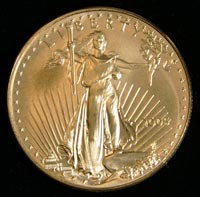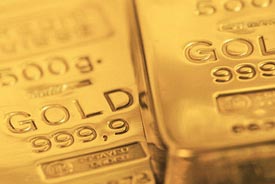Gold is underpriced by $1,400! Gold Long-term Target is $2,100!
Commodities / Gold & Silver Sep 27, 2007 - 08:55 AM GMT  Larry Edelson writes: I'm going to say it again — if you're not in the gold market, you're making a huge mistake.
Larry Edelson writes: I'm going to say it again — if you're not in the gold market, you're making a huge mistake.
Reason: Gold is the ultimate asset. It is the purest form of money, and the oldest, most durable wealth-preserving asset on the planet.
Governments can't debase it. It has no debts … no board of directors … no politicians or central bankers that can mess with its value. That's why gold has survived every economy history has ever witnessed, and preserved investors' purchasing power over a span of some 5,000 years.
And if you think gold is expensive right now at about $740 an ounce, think again. My longer-term target for gold is more than $2,100 an ounce …
That means gold is undervalued by as much as $1,400 an ounce!
Remember, back in 1980 gold hit a high of $850 an ounce. So to reach that same level now, gold will need to trade at $2,100 in today's pathetic greenbacks, which are being systematically devalued by our own government.
I don't really blame the folks in Washington. As I've said many times before, they have no other choice but to sacrifice the value of the dollar on the altar of all the debts that are turning sour in this country.
That's what's happening now, in spades. And if it's not a reason to own gold, I don't know what is.
Heck, just since last month, the price of gold has jumped more than $84 an ounce, or about 13%. That's three times the decline in the value of the dollar during the same period! Plus, we haven't even seen the worst of the dollar's decline yet.
So today, I want to tell you all about the many ways you can invest in gold, including my top six criteria for separating the good mining companies from the bad.
First, let's talk about two ways to buy physical gold …

#1. Gold bullion coins. The best examples are the American Eagle, Canadian Maple Leaf, and South African Krugerrand. These are great to buy, very liquid, and fun to look at. But they are not the best way to buy physical gold, in my opinion.
That's because buying these coins invariably entails paying premiums of anywhere from 4% to 7% over the actual value of the gold in the coins.
So, I prefer …
#2. Gold ingots and bars. Ingots are generally one ounce, but can be found in two or three ounce slabs as well. Bars generally come in sizes of five to 10 ounces, with the 10-ounce form more readily available.
Either way, you can get significantly more gold for your money than you can with bullion coins.
For example, at today's price of $740 per ounce, 100 ounces of gold is worth $74,000. But if you buy 100 of the one-ounce gold Canadian Maple Leafs, you'll pay $77,700 for the same metal content.
The additional $3,700 for the Maple Leafs is essentially for the design, minting and brokering of the coin.
Bottom line: For physical gold holdings, I recommend one-ounce ingots and 10-ounce bars. And for even larger purchases, you can consider the internationally-traded one-kilogram bars.

They're all relatively easy to buy — just make sure you are buying what is called "four nines fine" gold — metal that's .9999 (99.99%) pure gold.
The most common hallmarks are Johnson Matthey, Engelhard, Credit Suisse and Pamp. Most reputable dealers carry these ingots and bars in these hallmarks, or can readily acquire them for you.
How to Store Your Physical Gold …
For small purchases, say up to 20 or 30 ounces, I'd recommend the safe deposit box at a local bank. It's simple, safe and worry free. Even if the bank were to encounter financial difficulties, access to the box would not be affected.
Important note: I do not recommend storing any gold in your home or office!

For purchases beyond 20 or 30 ounces, use your dealer's storage facility as long as they offer non-fungible storage.
With non-fungible storage, your bullion or bag of coins is labeled with your name as your specific property. Moreover, it's stored separately from dealer assets and it is not commingled with the bullion of others.
I think this is the only type of dealer storage you can be fully comfortable with. So if your current dealer doesn't offer it, find one who does.
Always Keep Some Physical Gold. But for Larger Quantities Consider These Two Choices …
Sometimes storage is impractical, especially when you're holding large amounts of metal. Fortunately, there are a number of ways to invest in gold while avoiding some of the hassles of storage and delivery …
#1. Exchange-Traded Gold Funds (ETFs). My favorite is the streetTracks Gold Trust (GLD), which effectively offers investors physical gold in the format of an electronically-traded security, with each share representing one-tenth of an ounce of gold.
Two other choices are the iShares Comex Gold Trust (IAU) and the Central Fund of Canada, Ltd (CEF). However, among the three, I prefer the streetTracks Gold Trust because of its greater liquidity.
#2. Perth Mint Certificates (PMCs). These are issued by Western Australia's government-owned mint, and they give you title to a specified number of ounces of gold.
Some advantages:
![]() The Perth certificate comes with a government guarantee carrying a triple-A rating from S&P.
The Perth certificate comes with a government guarantee carrying a triple-A rating from S&P.
![]() Lloyd's of London insures your bullion against fraud and theft.
Lloyd's of London insures your bullion against fraud and theft.
![]() There are no storage fees.
There are no storage fees.
![]() The certificates are transferable.
The certificates are transferable.
![]() And you can redeem your certificates at the mint.
And you can redeem your certificates at the mint.
For more information on the Perth Certificate Program, check out this site .
One last thing on PMCs … if you buy them, specify you want "allocated" certificates, which has similar advantages to the non-fungible storage I described above.
Of course, one last way to get a stake in gold is through …
Gold Mining Shares
Warning: Not All Are Created Equal!
Provided you pick the right ones, gold mining shares not only give you an indirect vehicle for investing in gold, they can provide additional leverage and profit potential that goes far beyond what you can achieve with just the yellow metal on its own.
For example, let's say it costs a mining company an average of $250 to produce each ounce of gold. And let's say we're back in 2001 when an ounce of gold was selling for $260. At that point, the company's profit margin is just $10 per ounce.
Now, watch what happens with the price of gold at $740 an ounce: The company's profit margin jumps from $10 to $490 per ounce, or 4,900%!
This, in turn, can drive up the company's share price many times more than the corresponding price appreciation of bullion. Therein lies the leverage you can achieve by buying the right shares.
But two points of caution:
First, timing is critical.
If you buy while gold shares are near a temporary peak, you may initially be disappointed. Indeed, even right now, a correction in the price of many gold shares is likely, since they've had such a huge run up.
Second, if you own the wrong mining companies, you could be left behind as gold bullion surges.
Some companies will be unable to meet the gold demand, failing to capture a large portion of the profit opportunity.
Others, mistakenly fearing a sharp decline in gold prices, will hedge a lot of their production. In other words, they'll sell gold in the forward market or sell short gold futures. While this is designed to protect them from volatile prices, it could greatly reduce, or even wipe out, their profits for the year.
So to avoid disappointment, here are my top six criteria for selecting the best gold mining shares. These aren't hard-and-fast rules, but they are critical factors to consider:
1. Low debt. I generally like mining companies that have less than 50 cents in long-term debt per dollar of stockholders' equity.
2. Moderate hedging. Stick with companies that do not hedge more than 20% of their annual production. After all, what's the point of buying into a company's bullion to ride the bull market in gold when that same company has already sold most of its gold or production at today's lower prices, or worse, at yesterday's even lower prices?
3. Low cost of production. Try to stick with mining companies that have total production costs no higher than $300 per ounce. The lower the better, of course. And if it's a bit higher, it's necessarily not a deal killer. But the $300 mark is a good benchmark to work from.
4. Healthy expansion. Look for companies that are expanding their reserves through property acquisitions. Since new exploration can be expensive, I favor companies that are actively engaged in buying proven gold properties and smaller mines.
5. Experienced management. I want to see management that demonstrates not only a solid track record of experience, but also talent for thinking outside the box, especially when it comes to the acquisition of hot properties.
6. Don't go strictly by P/E ratios to determine value. Mining shares should also be valued on the basis of their proven reserves. Generally, the lower the ratio of the company's market cap to the value of its reserves, the better.
Never forget: A company with a market cap of, say, $10 billion with gold reserves worth $2 billion at the current gold price is much more expensive than a company with $4 billion in market cap and $2 billion in reserves!
Best wishes for your health and wealth,
Larry
P.S. For specific buy, sell and hold recommendations on my favorite gold shares — along with other great profit plays in natural resources — be sure to stay current with the Real Wealth Report .
This investment news is brought to you by Money and Markets . Money and Markets is a free daily investment newsletter from Martin D. Weiss and Weiss Research analysts offering the latest investing news and financial insights for the stock market, including tips and advice on investing in gold, energy and oil. Dr. Weiss is a leader in the fields of investing, interest rates, financial safety and economic forecasting. To view archives or subscribe, visit http://www.moneyandmarkets.com .
Money and Markets Archive |
© 2005-2022 http://www.MarketOracle.co.uk - The Market Oracle is a FREE Daily Financial Markets Analysis & Forecasting online publication.



